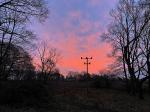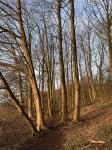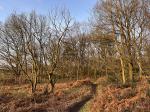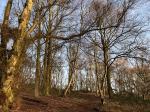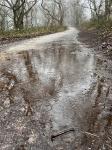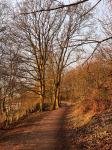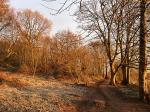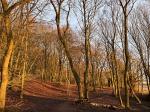Brayton Barff Through the Seasons.
Set in the Vale of York, South West of the market town of Selby and between the villages of Thorpe Willoughby and Brayton, lies Brayton Barff, a sandstone Hill approximately one hundred and fifty feet in height which was formed by glacial movement during the last Ice Age. It is a significant landmark in an otherwise flat landscape.
Today the site is primarily owned by Yorkshire Water with Selby District Council owning a small patch of the land adjacent to the A63 Selby bypass. A large underground reservoir occupies the centre of the site which delivers water to around 4.7 million customers throughout Yorkshire.
Within the Barff woodland over 40% of the trees are Sessile Oak which are generally found in semi natural woodlands in the north of the country. These trees are so called because its acorns are not held on stalks, like those of the English Oak (Pedunculate), but attached directly to the outer twigs. There are also several English Oak trees as well as some cross-hybrid oaks. These trees are known to support many species of flora and fauna, invertebrates, mosses, lichen and fungi.
During the Victorian times it is thought that the shipbuilders on the east coast would come over to the Barff for selected cuts of timber to build their sea going vessels.
The Barff also has a variety of other trees including Silver Birch, Beech, Sycamore, Holly, Rowan, Scots Pine, Alder, Hawthorne and European Larch. There are also several Yew, Willow, Hazel, Horse Chestnut and Wych Elm. As with similar woodlands there are a variety of bushes, including Honeysuckle, Elderberry, Gorse, Broom and Buddleia.
The history of Brayton Barff is quite vague, apparently during 1803 a beacon was lit on the Barff when the country was threatened with an invasion by Napoleon. In May 1935, to celebrate King George V's Silver Jubilee, a Bonfire was lit on the Barff as part of the celebrations.
Early issues of Ordnance Survey Maps dated 1903 clearly show a rifle range on the Barff, extending out to Mill Lane. During the 
Between 2001 – 2004 the A63 Selby bypass, 10km twin lane single carriageway was constructed which severed the South West corner of the Barff, adjacent to Selby Golf Course and resulted in a slight redesign of several holes on the golf course. Wooden fencing was erected as a result of this new road running alongside of the Barff and a footbridge constructed over the ‘new road’ following the line of the Bridal way which extends from Mill Lane. Around 2005/2006 a definite 2metre wide limestone aggregate footpath was laid forming a circular path around the outer edges of the woodland. This footpath is approximately 1.2 miles in length and takes about 30 minutes to circumnavigate at a leisurely pace.
In 2012 the Barff was declared an Ancient Oak Woodland and as such throughout 2012 and 2013 significant work had been carried out by the relevant agencies to cut and remove large swathes of non-native trees, creating at that time huge scars on the landscape. Some three years later the planting of the native trees have become well established and are flourishing. Ongoing maintenance work on the footpath around the bottom of the Barff was completed during the Summer of 2016.
A second phase of woodland maintenance commenced during the Autumn of 2019 with the removal of many old and diseased trees and the cutting back of the Gorse and Broom bushes, especially adjacent to the ‘bypass trail’, this work continued through till March 2020 with re planting continuing into April 2020.
Brayton Barff is a popular site for walkers and bird watchers alike and a path circling the outer perimeter of the Barff makes a pleasant thirty minute walk, giving views looking over towards Selby and the village of Brayton as well as the power stations of Drax and Eggborough..jpg)
For the early risers it is a great place to see some stunning sunrises over the villages of Brayton looking towards Drax Power Station, the same with the Sunsets looking over towards Eggborough and Monk Fryston.
The Barff changes with the Seasons and every visit can reveal something new, the woodland is a haven for wildlife. Records show that since 1982 one hundred and twelve species of bird have been seen in the woodland and at least 40 of those have bred here, including Tawny Owl, Buzzard, Green Woodpecker, Spotted Flycatcher, Goldcrest and Nuthatch to name just a few. On average over 70 species of bird are recorded each year. Further details of the bird life on the Barff can be found on the Brayton Barff Group Facebook page, especially the posts from Derek Cooper. Today ‘The Friends of Brayton Barff group’ led by Derek and a small team of volunteers help keep and maintain the cleanliness of the site as well as recording the wildlife and bird sightings.
The Barff is also home to fifteen different species of mammals, including Muntjac Deer, Pipistrelle Bat, Fox, and Field Vole.
Over eighty species of plant and wildflowers have been recorded, included Bee Orchid, Northern Marsh Orchid, Wood Anemone, Marsh Ragwort, Bluebell, White Bluebell, Bittersweet and Purple and White Foxgloves. Over twenty species of Butterfly have been recorded, including Marbled White, Brown Angus, Speckled Wood, Comma and Brimstone.
During the Autumnal months fungi thrives in this woodland environment, species including Fly Agaric, Beefsteak Tree Fungi, Chicken of the Wood, Sulphur Tufts, Stinkhorn, Ink cap, Puffballs and Hoof Bracket are just some of the many varieties that can be found here.
Click on the galleries shown below to expand the albums.
January 2024
Tuesday 2nd January. 08.00am A pleasant morning, just 6c, dull and overcast, very wet underfoot. The rain started at around 10.00am and continued for the rest of the day and into the night. The Barff is absolutely soddened due to the vast amount of rain we have had recently, many of the tracks leading off the main perimeter path are extremely muddy and slippery. We have a very vocal Song Thrush along the Bypass Trail often accompanied by several Coal and Great Tits. Blackbirds, Robin, Wrens, Long Tailed Tits and Chaffinch are still very active and noisy.
The Yellow Brain Fungi is still showing on the rotting moss covered trees and Creeping Corydalis continues to flower in several places around the woodland.
The farmers were out in the dark this morning with some big pieces of farming machinery, working under the light from their tractors, busily preparing the ground for the Summer crops, considering how wet and saturated the ground is around the fringes of the Barff, I am curious to know what they are planting.
Saturday 8th January, Persistent rain has seen flooding in several of the villages surrounding the Barff this past few days. The high-water levels in the River Aire and River Derwent have had an effect on the surrounding flood plains and soak aways, with many of the flood plains already holding water the water in the rivers has nowhere else to go, coupled with the inadequate sewerage system which cannot cope and starts to back up, it then finds its easiest means of escape which is through the manhole covers and into the streets of residential housing, unfortunately several streets around Brayton have been affected.
Friday 12th January was a cold 4c, it was another dull, miserable cloudy drizzly morning as it has been every morning this past week, the only consolation is that it is slowly getting lighter in the morning, and by 7.45am you can walk round the Barff without the need for a hand torch or headlamp. Although the perimeter footpath is quite dry, many of the tracks and trails leading off from the main path are still very wet and muddy, especially so those on the top of Tap Hill.
Saturday 13th and a touch of frost this morning, much brighter than yesterday with a lovely sunrise just after 8.00am. What a difference a day makes, compared to yesterday morning. Lots of birdsong this morning, The resident Song Thrush along the bypass trail was blasting out its song this morning but it was overshadowed by what I think was a huge flock of Corn Buntings on the other side of the bypass adjacent to the golf course, it was like a hundred piece orchestra playing out a symphony in the Royal Albert Hall, I have never heard as many birds as this before on the fringe of the Barff.
Grey Squirrels are still very active and am noticing several corn on the cobs left partly eaten on the perimeter footpath next to the maize field.
After two consecutive nights of frost, Wednesday 17th was the coldest morning of the year so far on the Barff, the temperature reading just -3c at 7.15am as I made my way across the woodland with Meg and Gracie. The ground was rock solid and has a distinctive crunch under foot as you stepped over the frozen soil, which made quite a change after several months of wet and mud. This morning was dry, crisp, and bright, it was a lovely morning for a walk. There was very little wind, and the only noise was that of the steady drone of traffic along the Selby bypass. The song thrush was busily chirping its head off along the Bypass trail, lots of Blackbirds were busily scurrying around under the leaf litter in their never-ending search for food. Great and Blue Tits were very vocal today as was the high-pitched call of the Goldcrest.
Friday 19th, Another hard overnight frost, temperature at 7.45am was -2c with a chilling northerly breeze. Lovely sunrise just after 8.00am, pleasant dry bright walk.
Saturday 20th, what a contrast to yesterday, with a dull cloudy and overcast morning, 3c. Great Tits were very vocal, a small flock of Long tailed tits were flitting out of the hawthorn edge along the bypass trail. The ground still firm, the cold light westerly breeze, strengthening later in the morning brought in rain showers. A Yellow weather warning has been issued for tomorrow with ‘Storm Isha’ bringing with it dangerous strengthening westerly winds up to 50mph for most of the country.
Sunday 21st, was a mild, dull, cloudy, and still morning, 5c, heavy overnight rain made the tracks and paths around the Barff very wet and muddy again. A lone song Thrush sat in a hawthorn bush was singing away to its heart’s content along the bypass trail this morning, standing proud like a choir boy about to sing a solo piece to a packed cathedral. Storm Isha has been and passed us by, other than an old rotten silver birch tree adjacent to the ‘shooting range’ on the perimeter track being blown down this area seems to have escaped the storm.
Tuesday 23rd, a lovely but very brief sunrise filled the sky this morning just before 8.00am, for a matter of minutes before the cloud rolled in and the rain arrived, the beginning of another, cold, wet and windy weather front sweeping across the country named ‘Storm Jocelyn’. The rain continued for most of the day and into the evening, compounded by a strengthening westerly wind which continued throughout Tuesday night and into the following morning, reaching gust of between 45mph – 50mph.
Wednesday 24th ‘Storm Jocelyn’ continued throughout the morning, the strong westerly wind howled through the woodland, fortunately, other than a lot of kindling lying on the floor that seems to be the only damage on the Barff, which is surprising considering the 50mph gusts this morning. In some of the sheltered spots. It was nice to hear the Song Thrush, Robin and Wren singing their heads of and lifting the spirits of the passing visitors. The wind and rain showers started to ease off later in the day.
Sunday 28th, was a beautiful morning, it was colder than yesterday at just 3c by 8.00am. The cool, light North westerly breeze just reminding you that we are still in the winter months. it was nice to hear my first Greater Spotted Woodpecker of the year, drumming its head off within 50 yards of the car park. The calmer weather seems to have woken the birds up this morning, bird song filled the air and for once masked the noise of the traffic travelling along the Selby bypass, the old Maize field which has been left dormant since the crop was harvested a couple of months ago has hosted a plethora of birds recently, including Reed Bunting, Brambling, Chaffinch, and Greenfinch to name but a few. Several Song Thrushes were giving it their all close to the old firing range, a flock of Long Tailed Tits were contently scurrying around amongst the hawthorn bushes along the bypass trail. Great and Blue tits were very vocal too around the woodland. It was nice to hear and see a huge skein of geese fly over the Barff this morning, there was well over one hundred birds all together in two flanks, honking and bleeping in a v formation heading over towards the ings at Fairburn. The big Crows and Rooks seem to have been out in force this morning, policing the skies around the woodland, closely followed by the constant purring of the Wood Pidgeon.
It is nice to see the Gorse bushes flowering and providing some colour in the woodland with their bright yellow florets. Love it or hate it, it does provide a good cover for many of our smaller bird species which take shelter in the bushes especially during the harsher weather. Gorse flowers also provide a good early source of nectar for bees and butterflies.
Monday 29th Overnight rain continued throughout the morning and late into the evening. It was exceptionally wet and muddy on the Barff this morning. A pair of Grey Squirrels were playing tig with each other on one of the big Oaks adjacent to the old Pump house, running up and down and along the branches at breakneck speed, how they do not fall off is beyond me, though I do know they have exceptionally sharp nails. The resident Song Thrush at the bottom of the sandy slope adjacent to the Bypass was on good form this morning, blasting out a melodic tune for a good five minutes or so. Despite the heavy rain it was exceptionally mild at 9c, with a very faint westerly breeze.
Wednesday 31st January started with a crisp overnight frost and temperature of 2C. There was a beautiful sunrise around 8.00am, lots of bird song once the warming sunlight hit the trees, especially walking along the top of Tap hill, our resident Thrushes were singing their heads off this morning, enjoying the morning sun, accompanied by all the regular choristers Robin, Wren, Blue Tit and Chaffinch, quite a cacophony of noise, I had to stop and listen to it for a few minutes. In the distance I could hear and see the Buzzard circling high in the sky over by the Maize field, being pestered by a pair of Crows.
As the month comes to an end, the mornings are certainly getting much lighter, you can walk around the Barff at 7.30am without the use of a head lamp or hand torch. Sunrise at the moment is around 8.00am with the sun rising from behind the cooling towers of Drax Power station.
It is nice to see leaves appearing on the Elderberry bushes and the Honeysuckle bushes on the upper slopes of the woodland, accompanied by several small clumps of Snowdrops which are appearing around some of the trees along the main perimeter footpath. Spring is not too far away.
|

